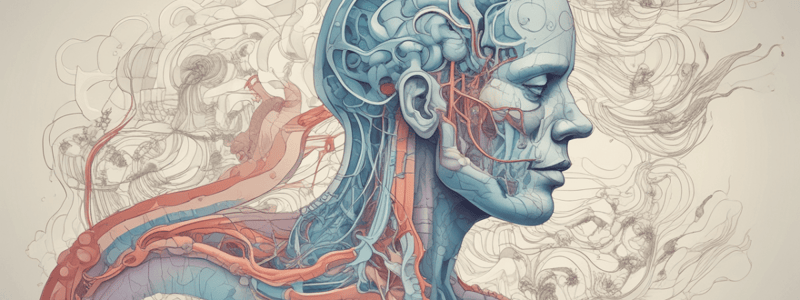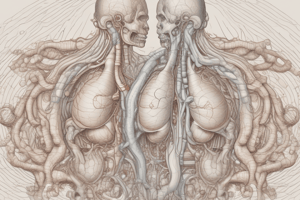Podcast
Questions and Answers
What happens if the amount of fluid in the interstitial space increases?
What happens if the amount of fluid in the interstitial space increases?
- Edema occurs (correct)
- The thickness of the respiratory membrane decreases
- Airway resistance increases
- Respiratory minute volume decreases
How is resistance (R) related to the cross-sectional area (A) of respiratory structures?
How is resistance (R) related to the cross-sectional area (A) of respiratory structures?
- R is directly proportional to A
- R is inversely proportional to A (correct)
- R is directly proportional to A squared
- R is inversely proportional to A squared
What is the relationship between airway resistance and permeability (K)?
What is the relationship between airway resistance and permeability (K)?
- They are directly related
- There is no relationship between them
- Permeability is directly related to airway resistance
- Permeability is inversely related to airway resistance (correct)
How is airway resistance typically measured?
How is airway resistance typically measured?
What driving force is needed to overcome resistance (R) according to the provided information?
What driving force is needed to overcome resistance (R) according to the provided information?
What physiological condition leads to a constant flow of 6L/min when airway resistance = 1?
What physiological condition leads to a constant flow of 6L/min when airway resistance = 1?
During expiration, air you exhale first comes from which part of the respiratory system?
During expiration, air you exhale first comes from which part of the respiratory system?
What happens to the partial pressure of O2 in mixed air during expiration?
What happens to the partial pressure of O2 in mixed air during expiration?
In the respiratory tree, which generation does the trachea belong to?
In the respiratory tree, which generation does the trachea belong to?
What does PDS stand for in the context of the respiratory system?
What does PDS stand for in the context of the respiratory system?
Which part of the respiratory system has a constant value of 150mm for WV?
Which part of the respiratory system has a constant value of 150mm for WV?
What happens when WV is greater than 0 in the respiratory system?
What happens when WV is greater than 0 in the respiratory system?
Which generation is considered the main site for gas exchange?
Which generation is considered the main site for gas exchange?
What type of cells occupy 95% of the alveolus due to their thin squamous nature?
What type of cells occupy 95% of the alveolus due to their thin squamous nature?
Which generation has cartilage for support and is not collapsible?
Which generation has cartilage for support and is not collapsible?
What is the function of Type 2 alveolar cells?
What is the function of Type 2 alveolar cells?
Which component of alveolar fluid is responsible for reducing surface tension?
Which component of alveolar fluid is responsible for reducing surface tension?
Why is airway resistance considered small and negligible?
Why is airway resistance considered small and negligible?
What is the relationship between airway resistance and cross-sectional area?
What is the relationship between airway resistance and cross-sectional area?
What causes most of the airway resistance in the respiratory system?
What causes most of the airway resistance in the respiratory system?
How does vascular resistance compare to airway resistance?
How does vascular resistance compare to airway resistance?
When does asthma become reversible according to the information provided?
When does asthma become reversible according to the information provided?
Where does the air with the highest PO2 come from during mixed air expiration?
Where does the air with the highest PO2 come from during mixed air expiration?
Which part of the respiratory system has a constant value of 150mm for ADS?
Which part of the respiratory system has a constant value of 150mm for ADS?
What is the generation number for the secondary bronchi in the respiratory tree?
What is the generation number for the secondary bronchi in the respiratory tree?
Which type of cells occupy 95% of the alveoli due to their thin squamous nature?
Which type of cells occupy 95% of the alveoli due to their thin squamous nature?
What happens when the amount of fluid in the interstitial space increases?
What happens when the amount of fluid in the interstitial space increases?
What is the main site for gas exchange in the respiratory system?
What is the main site for gas exchange in the respiratory system?
How many divisions/branches make up the respiratory tree?
How many divisions/branches make up the respiratory tree?
What is the main function of Type 2 alveolar cells?
What is the main function of Type 2 alveolar cells?
Why are generations #11 to #23 considered collapsible structures in the respiratory system?
Why are generations #11 to #23 considered collapsible structures in the respiratory system?
Which generation in the respiratory tree is responsible for gas exchange?
Which generation in the respiratory tree is responsible for gas exchange?
What is the primary function of Type 1 alveolar cells?
What is the primary function of Type 1 alveolar cells?
Why is generation #23 referred to as the alveolus (closed bulb)?
Why is generation #23 referred to as the alveolus (closed bulb)?
Which type of cell occupies 5% of the alveolus and secretes surfactant?
Which type of cell occupies 5% of the alveolus and secretes surfactant?
What structures support generations #0 to #10 in the respiratory system?
What structures support generations #0 to #10 in the respiratory system?
What happens to the thickness of the respiratory membrane when there is an increase in fluid in the interstitial space?
What happens to the thickness of the respiratory membrane when there is an increase in fluid in the interstitial space?
How is airway resistance related to permeability (K) in the respiratory system?
How is airway resistance related to permeability (K) in the respiratory system?
Which factor is used to overcome resistance (R) in the respiratory system?
Which factor is used to overcome resistance (R) in the respiratory system?
How is airway resistance typically expressed when measuring it indirectly?
How is airway resistance typically expressed when measuring it indirectly?
What does a high value of resistance (R) indicate about the pressure difference required for flow?
What does a high value of resistance (R) indicate about the pressure difference required for flow?
Why is airway resistance considered a vague concept in the context of the respiratory system?
Why is airway resistance considered a vague concept in the context of the respiratory system?
What factor is inversely related to airway resistance in the respiratory system?
What factor is inversely related to airway resistance in the respiratory system?
Why is airway resistance considered small and negligible?
Why is airway resistance considered small and negligible?
What contributes to most of the airway resistance in the respiratory system?
What contributes to most of the airway resistance in the respiratory system?
Why does vascular resistance in the cardiovascular system differ significantly from airway resistance?
Why does vascular resistance in the cardiovascular system differ significantly from airway resistance?
What leads to the reversibility of asthma, as indicated in the text?
What leads to the reversibility of asthma, as indicated in the text?
How does the NET cross-sectional area impact airway resistance?
How does the NET cross-sectional area impact airway resistance?
What causes the significant difference in resistance between cardiovascular and respiratory systems?
What causes the significant difference in resistance between cardiovascular and respiratory systems?
In what aspects do vascular and airway resistances differ significantly?
In what aspects do vascular and airway resistances differ significantly?
During expiration, where does the air with the highest PCO2 come from in the respiratory system?
During expiration, where does the air with the highest PCO2 come from in the respiratory system?
Which generation of the respiratory tree is considered non-collapsible and has cartilage for support?
Which generation of the respiratory tree is considered non-collapsible and has cartilage for support?
In the context of the respiratory system, where do most of the airway resistances originate from?
In the context of the respiratory system, where do most of the airway resistances originate from?
Which part of the respiratory system contributes significantly to airway resistance due to its narrowing and branching?
Which part of the respiratory system contributes significantly to airway resistance due to its narrowing and branching?
In the given respiratory system hierarchy, which structure belongs to generation #0?
In the given respiratory system hierarchy, which structure belongs to generation #0?
Which part of the respiratory tree is associated with a constant value of 150mm for ADS?
Which part of the respiratory tree is associated with a constant value of 150mm for ADS?
Based on the provided information, which part of the respiratory system serves as the primary site for gas exchange?
Based on the provided information, which part of the respiratory system serves as the primary site for gas exchange?
What is the relationship between resistance (R) and cross-sectional area (A) of respiratory structures?
What is the relationship between resistance (R) and cross-sectional area (A) of respiratory structures?
What is a key difference between airway resistance and vascular resistance?
What is a key difference between airway resistance and vascular resistance?
Whose respiratory rate would have a higher resistance value according to the information provided?
Whose respiratory rate would have a higher resistance value according to the information provided?
How is airway resistance typically measured indirectly?
How is airway resistance typically measured indirectly?
Why is the airway resistance considered negligible in comparison to vascular resistance?
Why is the airway resistance considered negligible in comparison to vascular resistance?
What does a high value of resistance (R) signify about the pressure difference needed for flow?
What does a high value of resistance (R) signify about the pressure difference needed for flow?
What factor contributes significantly to the high resistance in large airways?
What factor contributes significantly to the high resistance in large airways?
What is the opposite of airway resistance in the context of fluid dynamics?
What is the opposite of airway resistance in the context of fluid dynamics?
Why is airway resistance challenging to measure directly?
Why is airway resistance challenging to measure directly?
When does asthma become reversible according to the information provided?
When does asthma become reversible according to the information provided?
What happens to the thickness of the respiratory membrane when there is an increase in fluid in the interstitial space?
What happens to the thickness of the respiratory membrane when there is an increase in fluid in the interstitial space?
What contributes to most of the airway resistance in the respiratory system?
What contributes to most of the airway resistance in the respiratory system?
What is the relationship between permeability (K) and airway resistance in the respiratory system?
What is the relationship between permeability (K) and airway resistance in the respiratory system?
What is the main difference between generations #0 to #10 and generations #11 to #23 in the respiratory system?
What is the main difference between generations #0 to #10 and generations #11 to #23 in the respiratory system?
Which component of alveolar fluid is primarily responsible for reducing surface tension?
Which component of alveolar fluid is primarily responsible for reducing surface tension?
What is the main function of Type 2 alveolar cells in the respiratory system?
What is the main function of Type 2 alveolar cells in the respiratory system?
Which type of cell occupies 95% of the alveolus due to its thin squamous nature?
Which type of cell occupies 95% of the alveolus due to its thin squamous nature?
Why are generations #11 to #23 considered collapsible structures in the respiratory system?
Why are generations #11 to #23 considered collapsible structures in the respiratory system?
What is the diameter of an alveolus as mentioned in the provided information?
What is the diameter of an alveolus as mentioned in the provided information?
What is the primary site for gas exchange in the respiratory system?
What is the primary site for gas exchange in the respiratory system?
Flashcards are hidden until you start studying





